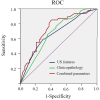Sonographic Features of Triple-Negative Breast Carcinomas Are Correlated With mRNA-lncRNA Signatures and Risk of Tumor Recurrence
- PMID: 33542899
- PMCID: PMC7851073
- DOI: 10.3389/fonc.2020.587422
Sonographic Features of Triple-Negative Breast Carcinomas Are Correlated With mRNA-lncRNA Signatures and Risk of Tumor Recurrence
Abstract
Background: To determine a correlation between mRNA and lncRNA signatures, sonographic features, and risk of recurrence in triple-negative breast cancers (TNBC).
Methods: We retrospectively reviewed the data from 114 TNBC patients having undergone transcriptome analysis. The risk of tumor recurrence was determined based on the correlation between transcriptome profiles and recurrence-free survival. Ultrasound (US) features were described according to the Breast Imaging Reporting and Data System. Multivariate logistic regression analysis determined the correlation between US features and risk of recurrence. The predictive value of sonographic features in determining tumor recurrence was analyzed using receiver operating characteristic curves.
Results: Three mRNAs (CHRDL1, FCGR1A, and RSAD2) and two lncRNAs (HIF1A-AS2 and AK124454) were correlated with recurrence-free survival in patients with TNBC. Among the three mRNAs, two were upregulated (FCGR1A and RSAD2) and one was downregulated (CHRDL1) in TNBCs. LncRNAs HIF1A-AS2 and AK124454 were upregulated in TNBCs. Based on these signatures, an integrated mRNA-lncRNA model was established using Cox regression analysis to determine the risk of tumor recurrence. Benign-like sonographic features, such as regular shape, circumscribed margin, posterior acoustic enhancement, and no calcifications, were associated with HIF1A-AS2 expression and high risk of tumor recurrence (P<0.05). Malignant-like features, such as irregular shape, uncircumscribed margin, no posterior acoustic enhancement, and calcifications, were correlated with CHRDL1 expression and low risk of tumor recurrence (P<0.05).
Conclusions: Sonographic features and mRNA-lncRNA signatures in TNBCs represent the risk of tumor recurrence. Taken together, US may be a promising technique in determining the prognosis of patients with TNBC.
Keywords: long non-coding RNA; messenger RNA; triple-negative breast cancer; tumor recurrence; ultrasound.
Copyright © 2021 Li, Zhou, Shi, Li, Zhou and Chang.
Conflict of interest statement
The authors declare that the research was conducted in the absence of any commercial or financial relationships that could be construed as a potential conflict of interest.
Figures





Similar articles
-
Prediction for pathological and immunohistochemical characteristics of triple-negative invasive breast carcinomas: the performance comparison between quantitative and qualitative sonographic feature analysis.Eur Radiol. 2022 Mar;32(3):1590-1600. doi: 10.1007/s00330-021-08224-x. Epub 2021 Sep 14. Eur Radiol. 2022. PMID: 34519862
-
Transcriptome Analysis of Triple-Negative Breast Cancer Reveals an Integrated mRNA-lncRNA Signature with Predictive and Prognostic Value.Cancer Res. 2016 Apr 15;76(8):2105-14. doi: 10.1158/0008-5472.CAN-15-3284. Epub 2016 Mar 3. Cancer Res. 2016. PMID: 26921339
-
Comprehensive Transcriptome Profiling Reveals Multigene Signatures in Triple-Negative Breast Cancer.Clin Cancer Res. 2016 Apr 1;22(7):1653-62. doi: 10.1158/1078-0432.CCR-15-1555. Epub 2016 Jan 26. Clin Cancer Res. 2016. PMID: 26813360
-
Long non-coding RNAs: implications in targeted diagnoses, prognosis, and improved therapeutic strategies in human non- and triple-negative breast cancer.Clin Epigenetics. 2018 Jun 27;10:88. doi: 10.1186/s13148-018-0514-z. eCollection 2018. Clin Epigenetics. 2018. PMID: 29983835 Free PMC article. Review.
-
Systematic Review and Meta-analysis of the Malignant Ultrasound Features of Triple-Negative Breast Cancer.J Ultrasound Med. 2020 Oct;39(10):2013-2025. doi: 10.1002/jum.15309. Epub 2020 Apr 27. J Ultrasound Med. 2020. PMID: 32339328
Cited by
-
Prediction for pathological and immunohistochemical characteristics of triple-negative invasive breast carcinomas: the performance comparison between quantitative and qualitative sonographic feature analysis.Eur Radiol. 2022 Mar;32(3):1590-1600. doi: 10.1007/s00330-021-08224-x. Epub 2021 Sep 14. Eur Radiol. 2022. PMID: 34519862
-
Concomitant medication of cetirizine in advanced melanoma could enhance anti-PD-1 efficacy by promoting M1 macrophages polarization.J Transl Med. 2022 Sep 30;20(1):436. doi: 10.1186/s12967-022-03643-w. J Transl Med. 2022. PMID: 36180872 Free PMC article.
-
A comprehensive genomic and transcriptomic dataset of triple-negative breast cancers.Sci Data. 2022 Sep 24;9(1):587. doi: 10.1038/s41597-022-01681-z. Sci Data. 2022. PMID: 36153392 Free PMC article.
-
Survival outcome assessment for triple-negative breast cancer: a nomogram analysis based on integrated clinicopathological, sonographic, and mammographic characteristics.Eur Radiol. 2022 Oct;32(10):6575-6587. doi: 10.1007/s00330-022-08910-4. Epub 2022 Jun 27. Eur Radiol. 2022. PMID: 35759017 Free PMC article.
-
A functional gene module identification algorithm in gene expression data based on genetic algorithm and gene ontology.BMC Genomics. 2023 Feb 17;24(1):76. doi: 10.1186/s12864-023-09157-z. BMC Genomics. 2023. PMID: 36797662 Free PMC article.
References
LinkOut - more resources
Full Text Sources
Other Literature Sources

